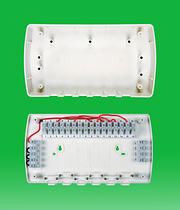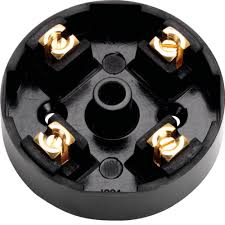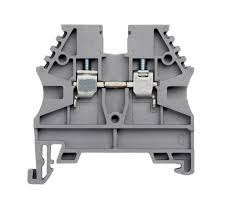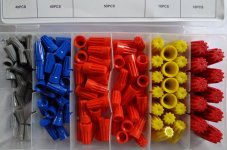Just curious
Why are wire nuts used, at least in the US, in junction boxes, switch boxes, outlet boxes, etc. for ac mains connections? why not crimp connectors as we use in our chassis?
I find them frustrating, especially when tying together 3 wires.
Why are wire nuts used, at least in the US, in junction boxes, switch boxes, outlet boxes, etc. for ac mains connections? why not crimp connectors as we use in our chassis?
I find them frustrating, especially when tying together 3 wires.
I think that correctly used they create an easy gas-tight connection. Crimp connectors require more time & labor. Are you using the correct size?
Agree, I have a section box with my collection of wire nuts. They come in many sizes. If you are tying three 12ga wires together, you need a nut designed for it.
They are cheap, reliable, installed without tools, and easily undone for changes or troubleshooting.
I find it baffling when a customer brings me an amp, where the wires to the speaker plug onto the board with a molex connector, yet they leave the connector on the board and cut the wires a couple inches out. ARRRGGGHHH! Just unplug the thing... I see wire nuts like that. A crimp is a splice, while a wire nut is a connector.
They are cheap, reliable, installed without tools, and easily undone for changes or troubleshooting.
I find it baffling when a customer brings me an amp, where the wires to the speaker plug onto the board with a molex connector, yet they leave the connector on the board and cut the wires a couple inches out. ARRRGGGHHH! Just unplug the thing... I see wire nuts like that. A crimp is a splice, while a wire nut is a connector.
It is important to strip the wires to the correct length, and align the wires (lengthwise) into the wire nut. I've also found some brands far easier to use than others. My favorite is "Ideal" brand. Use the correct size for your application.
One reason crimp connectors are not used: Most house wiring is solid wire, a no-no with crimps. E
Can you post a pic of a wire nut..
Years ago Screwits were used in American industry..however they were banned in the UK.
Regards
M. Gregg
Years ago Screwits were used in American industry..however they were banned in the UK.
Regards
M. Gregg
Last edited:
Attachments
Yes,
that's what we called screwits.
http://www.theiet.org/Forums/Forum/messageview.cfm?catid=226&threadid=3659
Apparently they had problems with earths becoming disconnected and live cables on equipment vibrating loose and touching down making metalwork live on machines.
The ones we had were yellow with little plastic wings on the sides. (Provided by the company at the time)
We used them for years until the sudden change.
Pronounced "screw-it" I don't even remember where the name came from 😀.
Regards
M. Gregg
that's what we called screwits.
http://www.theiet.org/Forums/Forum/messageview.cfm?catid=226&threadid=3659
Apparently they had problems with earths becoming disconnected and live cables on equipment vibrating loose and touching down making metalwork live on machines.
The ones we had were yellow with little plastic wings on the sides. (Provided by the company at the time)
We used them for years until the sudden change.
Pronounced "screw-it" I don't even remember where the name came from 😀.
Regards
M. Gregg
Last edited:
In the UK,
They advise not using junction boxes..if they are used they should be accessible..🙄
It causes a few problems with the definition on what is accessible. Under floor boards is not really considered accessible because
people put laminate flooring down and this changes the situation..
So things like this have been used..
However obviously its dependant on the standards and where its being fitted etc.
I have seen things like this:
However the accessibility is the issue.
Years ago people used to just push strip connectors tapped up into ceiling cavities to fit lights, however its not allowed now.
Central heating in houses uses its own type of box like this:

Obviously the current rating etc has to be taken into account.
The old long time used was this:

But if the box is not accessible its supposed to be a permanent joint which makes this a bit difficult to use now..so soldered or crimped was the idea.
I hope this is of help..there are fittings for ponds outside it goes on (waterproof)..etc
In the UK fittings have whats called an IP rating depending on the type of environment its going to be used in.
Ie splash proof,drip proof, flame proof etc
The above are domestic, on machines we use metal boxes with clip in connectors and gasket sealed lids. This allows for conduit or SWA (steel wire armoured) connectors etc. Like this:


I feel like I'm droning on so I'll stop..😀
Here is an example of a UK supplier so you can have a search..
http://www.neweysonline.co.uk/aluminium+box/q01.r10.1/Search.raction
( I have no connection its just for interest)
Regards
M. Gregg
They advise not using junction boxes..if they are used they should be accessible..🙄
It causes a few problems with the definition on what is accessible. Under floor boards is not really considered accessible because
people put laminate flooring down and this changes the situation..
So things like this have been used..
An externally hosted image should be here but it was not working when we last tested it.
However obviously its dependant on the standards and where its being fitted etc.
I have seen things like this:
An externally hosted image should be here but it was not working when we last tested it.
However the accessibility is the issue.
Years ago people used to just push strip connectors tapped up into ceiling cavities to fit lights, however its not allowed now.
Central heating in houses uses its own type of box like this:

Obviously the current rating etc has to be taken into account.
The old long time used was this:
But if the box is not accessible its supposed to be a permanent joint which makes this a bit difficult to use now..so soldered or crimped was the idea.
I hope this is of help..there are fittings for ponds outside it goes on (waterproof)..etc
In the UK fittings have whats called an IP rating depending on the type of environment its going to be used in.
Ie splash proof,drip proof, flame proof etc
The above are domestic, on machines we use metal boxes with clip in connectors and gasket sealed lids. This allows for conduit or SWA (steel wire armoured) connectors etc. Like this:
I feel like I'm droning on so I'll stop..😀
Here is an example of a UK supplier so you can have a search..
http://www.neweysonline.co.uk/aluminium+box/q01.r10.1/Search.raction
( I have no connection its just for interest)
Regards
M. Gregg
Last edited:
If you strip the Romex a little bit long, align them up and twist clockwise with your electrician's pliers, then clip the pig tail to the proper length, the wire nut will screw on easily and tightly.😉
In Canada, professional electricians sometimes do use crimp connections; I've seen 'em plenty of times when working on house wiring. Specialized crimper to compress the metal 'sleeve' over the wires and an integral plastic cover over. Quick and cheap but not reversible.
We had all kinds of problems when aluminum wiring was the 'latest and greatest' for a while - special wire nuts and compound are needed to connect Al properly.
BTW, the electrical code anywhere in Canada that I've checked doesn't allow junction boxes in 'inaccessible' areas....no boxes buried in walls or under flooring are allowed. Boxes in open ceiling areas in basements or attics are allowed, and this can be a major hassle if you want to 'finish' a basement into a living space and put up drywall on the walls and ceilings.
I was in my local electronic supply place the other day, and on the counter they had a display of 'clamp'-style wire connectors which supposedly will replace wire nuts...which I doubt, since they were dollars/clamp.
My experience with UK electrical standards is from India...I kinda miss the sizzling and sparking that let me know when the electricity was 'on again' in the neighbourhood.🙂
We had all kinds of problems when aluminum wiring was the 'latest and greatest' for a while - special wire nuts and compound are needed to connect Al properly.
BTW, the electrical code anywhere in Canada that I've checked doesn't allow junction boxes in 'inaccessible' areas....no boxes buried in walls or under flooring are allowed. Boxes in open ceiling areas in basements or attics are allowed, and this can be a major hassle if you want to 'finish' a basement into a living space and put up drywall on the walls and ceilings.
I was in my local electronic supply place the other day, and on the counter they had a display of 'clamp'-style wire connectors which supposedly will replace wire nuts...which I doubt, since they were dollars/clamp.
My experience with UK electrical standards is from India...I kinda miss the sizzling and sparking that let me know when the electricity was 'on again' in the neighbourhood.🙂
They're most often referred to as 'Marettes' here.
Twist-on wire connector - Wikipedia, the free encyclopedia
The only nuts I have had trouble with is the ones without the copper helix inside. Why they ever made those is a mystery. There's no real bite into the wire so you end up having to use good ol' hockey tape to hold them on.
Twist-on wire connector - Wikipedia, the free encyclopedia
The only nuts I have had trouble with is the ones without the copper helix inside. Why they ever made those is a mystery. There's no real bite into the wire so you end up having to use good ol' hockey tape to hold them on.
The only nuts I have had trouble with is the ones without the copper helix inside. Why they ever made those is a mystery.
Quick and easy one-handed disconnect. 😉
Yuck, wire nuts are awful. Don't know why we still use them or why they are still allowed. I've recently seen the crimped wires here in the USA, seems better. I prefer the terminal blocks used in Europe. Not as fast, for sure, but so much more secure.
There may be "better" ways to connect wires than wire nuts, but in my almost 70 years on this earth, I can think of only one instance where a wire nut came loose in house wiring anywhere I lived. Tightened it up and the porch light switch worked again.
Safety first, but this never dawned on me. "This" being the discussion here. The mains inlet & wire nut topics make more sense now.
I was taught to tightly twist the wire bundle with electrical pliers, trim them to ensure that no uninsulated strands would be outside the nut, then add two wraps of electrical tape around the base of the wirenut and onto the wire bundle wrapped in the direction the nut tightens. I've never had a connection issue using this technique.
Safety first, but this never dawned on me. "This" being the discussion here. The mains inlet & wire nut topics make more sense now.
That's a Really good discussion. I'm not sure it was addressed, but do UK homes have a centralized breaker box in addition to the fuses on each individual outlet?
- Status
- Not open for further replies.
- Home
- General Interest
- Everything Else
- why wire nuts for mains connection?
